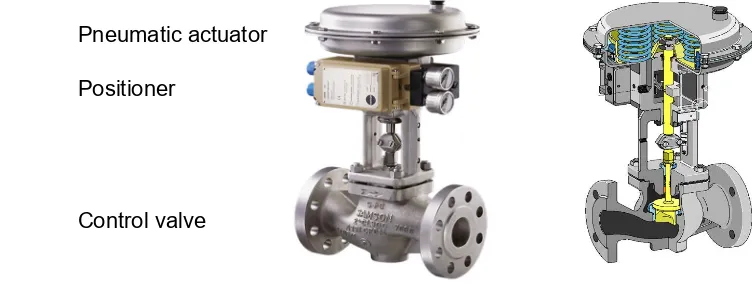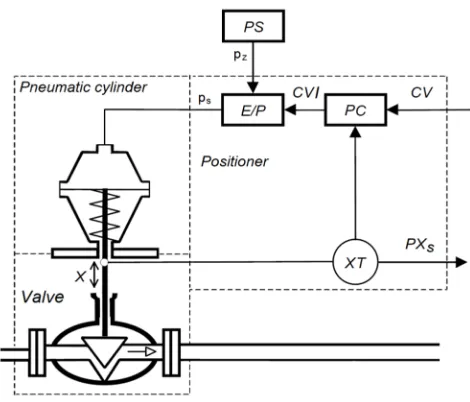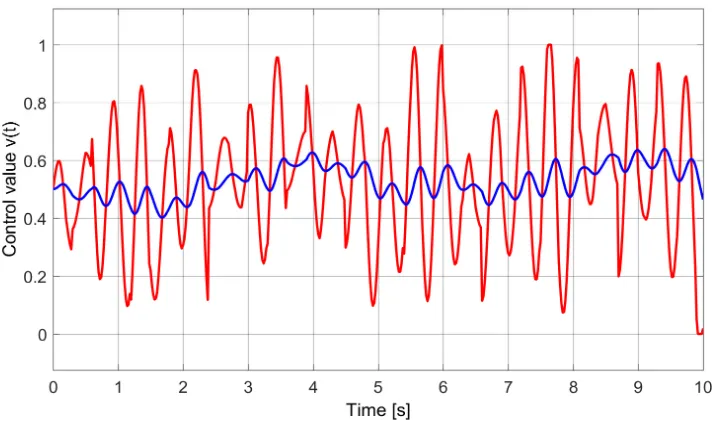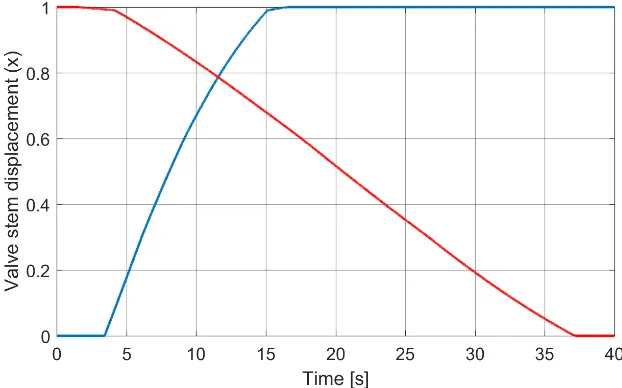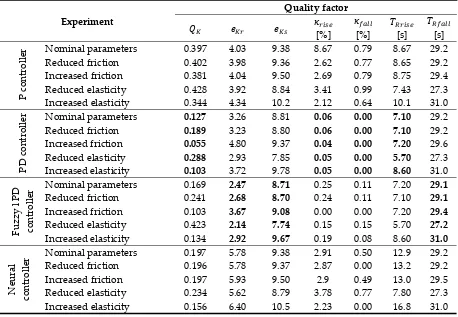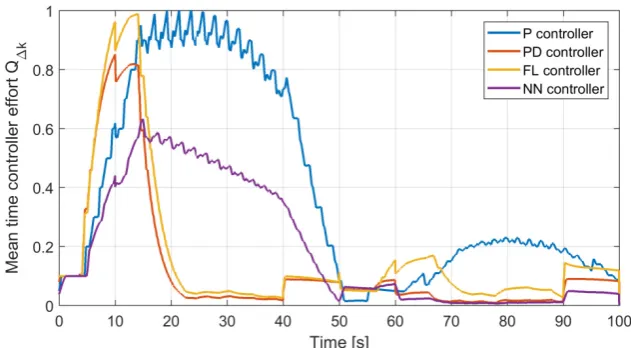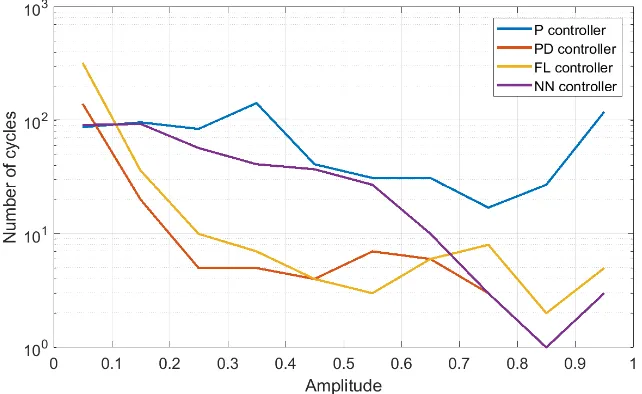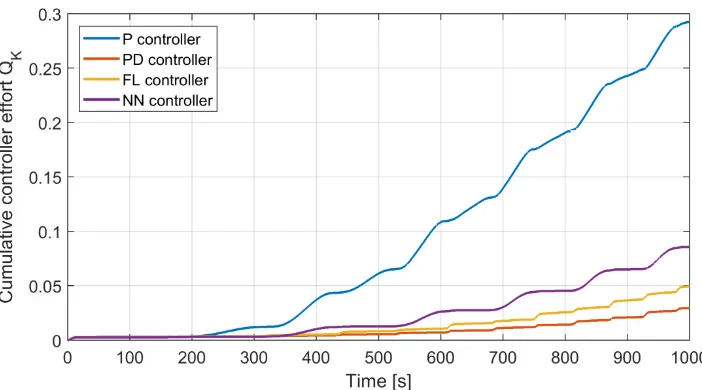Article
1
The trade-off between the controller effort and
2
control quality on example of an electro-pneumatic
3
final control element
4
Michał Bartyś 1,*, Bartłomiej Hryniewicki 2
5
1 Warsaw University of Technology, Institute of Automatic Control and Robotics; PL 02-525 Warsaw,
6
św. A. Boboli 8, bartys@mchtr.pw.edu.pl
7
2 Warsaw University of Technology, Institute of Automatic Control and Robotics; PL 02-525 Warsaw,
8
św. A. Boboli 8, 258971@pw.edu.pl
9
* Correspondence: bartys@mchtr.pw.edu.pl; Tel.: +48-501-697-545
10
11
Featured Application: process control engineering practice. This paper shows that by the proper
12
selection of the structure and parameters of the internal controller of the final control element, one
13
can achieve two seemingly contradictory outcomes. On the one hand, better quality control, while
14
on the other, simultaneous reduction of the controller effort, which in turn leads to a significant
15
extension of the mean-time-between-failures of the final control element. This has a pertinent
16
impact on functional safety and economy of the process.
17
Abstract: For many years, the programmable positioners have been widely applied in structures of
18
modern electro-pneumatic final control elements. The positioner consists of an electro-pneumatic
19
transducer, embedded controller and measuring instrumentation. Electro-pneumatic transducers
20
that are used in positioners are characterized by a relatively short mean time-to-failure. The
21
practical and economical method of a reasonable prolongation of this time is proposed in this
22
paper. It is principally based on assessment and minimizing the effort of the embedded controller.
23
For this purpose, were introduced: the control value variability, mean-time and the cumulative
24
controller's effort. The diminishing of controller effort has significant practical repercussions,
25
because it reduces the intensity of mechanical wear of the final control element components. On the
26
other hand, the reduction of the cumulative effort is important in the context of process economy
27
due to limitation of the consumption of energy of compressed air supplying the final control
28
element. Therefore, the minimization of introduced effort factors has an impact on increasing the
29
functional safety and economics of the controlled process. As a result of the performed simulations,
30
the recommendations regarding the selection of the structure and tuning of positioner controller
31
were elaborated. The simulations were performed in the Matlab-Simulink environment with the
32
use of the liquid level control system in which a phenomenological model of a final control element
33
was deployed. It has been proven that under appropriate conditions, it is possible to extend
34
significantly the lifetime of the final control element and simultaneously enhance the control
35
quality factors.
36
Keywords: final control element; electro-pneumatic transducer, controller effort, control quality
37
factors, wear, mean-time-between-failures
38
39
1. Introduction
40
In the structures of the closed loop industrial automation systems, we can generally distinguish:
41
controlled systems, controllers, measuring instrumentation and final control elements [1-3]. The
42
general structure of a single-loop control system is depicted in Figure 1. The final control elements
43
are physical units directly affecting the streams of energy and materials. In the structure of a control
44
system, they simply play the role of adapters between controllers and controlled systems.
45
In fact, the final control elements are acting as energy or power converters that convert the
46
low-energy or informative control value (CV) into a high-energy driving signal (CVa). Clearly, due to
47
the principle of energy conservation, the final control elements require an additional auxiliary power
48
supply source.
49
50
51
52
53
54
55
56
Figure 1. Block diagram of the structure of the closed loop automatic control system. Notion: SP –
57
setpoint; PVs – measured value of process variable; e - control error; CV – controller output; CVa –
58
final control element actuator output; PV- process variable.
59
The main interest of this paper is focused on the certain class of final control elements in which
60
the compressed air is used as an auxiliary energy supply source. These elements are commonly used
61
in automatic control systems used in the following industries: power, chemical, petrochemical,
62
pharmaceutical and food.
63
A typical electro-pneumatic final control element consists of a pneumatic actuator with linear or
64
rotational movement of its rod, a positioner and a control valve (Figure 2). By adjusting the position
65
of the valve plug attached to the end of actuator’s rod towards the valve seat, it is possible to control
66
the flow rate of a medium passing through the valve.
67
The primary goal of the positioner is to follow-up the CV. In order to do it, the positioner has to
68
control the pressure of the pneumatic actuator in such a way that the position of the valve plug will
69
depend exclusively on CV and will suppress the influence of the disturbances such as: changes of
70
operating temperature, supply pressure fluctuations, changes in the static and dynamic load of the
71
actuator’s rod, friction and the evolution of friction forces.
72
73
74
75
76
77
78
79
Figure 2. An example of an electro-pneumatic final control element and cross-section of its
80
mechanical construction [4,5].
81
The final static and dynamic properties of the actuator are shaped by the positioner. In fact, the
82
positioner is a specialized, autonomous control system of the rod position. The simplified block
83
diagram of the final control element is shown in Figure 3.
84
Control valve Positioner
Pneumatic actuator
element Final control CV
e Controller
System
PVSP
PVs
Instrument CVa
85
Figure 3. Block diagram of an electro-pneumatic final control element. Notions: CV – output of
86
external controller; CVI – output of internal controller; PC – internal controller;
87
E/P – electro-pneumatic transducer; PS – compressed air supply; pz - supply air pressure; ps - the
88
output pressure of the E/P transducer; X - displacement of the valve plug; XT – displacement
89
transducer of the actuator's rod; PXs - measured displacement of the actuator's rod [6].
90
When applied, one requires from the final control element a repetitive non-hysteresis static
91
characteristics, aperiodic step response and minimum control time. In principle, realisation of these
92
requirements becomes realistic only due to the use of a positioner.
93
It should be noted that the final control elements are exposed to adverse environmental
94
conditions such as thermal shocks, a wide range of operating temperatures, vibrations, humidity,
95
dusty pollutants, corrosive working environment and electromagnetic interference. Therefore, the
96
final control elements are classified as belonging to the group of elements of automation systems
97
subjected to the most frequent failures.It is estimated that among instrumentation, actuators and
98
technological components, the share of failures of final control elements exceeds 45%. The faulty
99
final control element can lead to a deterioration of the quality of the final product, and can even lead
100
to the process shut-down. All these factors influence the safety of the process and humans involved,
101
as well as worsen the economic indices of the process. For this reason, the assurance of the most
102
trouble-free operation of such devices becomes more important. In this context, the issues of fault
103
prediction and diagnostics, as well as ways of prevention actions and fault tolerant control become
104
particularly pertinent [7]. Most frequently, the electro-pneumatic transducer is subject to fail in case
105
of electro-pneumatic final control elements. This component fails due to poor quality of supply air,
106
friction wear of its mechanical components and material fatigue of its moving parts.
107
In this paper, a practical and economic approach to prolongation of final control element
108
lifetime is proposed. It is based on appropriate shaping and tuning of the positioner controller in
109
such a manner that it results in the limitation of the amplitude and of the number of cycles on its
110
output. This directly influences the wear and fatigue of moving elements of the electro-pneumatic
111
transducer. This type of approach, due to the conclusions drawn from the Wöhler’s fatigue curve [8],
112
has significant impact on mean-time-between-failures (MTBF), and therefore, reduces wear and
113
increases functional safety of the controlled process.
114
The essence of the proposed approach is to change the structure and parameters of the
115
positioner controller (PC) in order to minimize its effort, but not at the expense of worsening the
116
control quality factors of the controlled system in which such an element is used.
117
The results of research of the proposed approach were obtained in the Matlab-Simulink
118
simulation environment with the use of the final control element model [9] which is recognized
119
widely in the field of diagnostics and process safety. This to some extent enhances trustworthiness of
120
2. The controller effort
122
Before we discuss the problem of minimizing controller’s effort, let us define a few effort related
123
terms for the continuous and discrete time domain systems.
124
Definition 1. Define the normalized variability of the controller output 𝑣 𝑡 as:
125
𝑉 𝑡 = 1
∆𝑣 𝑑𝑣 𝑡
𝑑𝑡 , (1)
where: ∆𝑣 = |𝑣 − 𝑣 | – nominal range of controller output.
126
127
Definition 2. Define the controller's mean time effortover time interval ∆𝑡 as an average normalized
128
variability of the controller output.
129
𝑄 ∆𝑡 = 1
∆𝑡 𝑉 𝑡 𝑑𝑡 = 1 ∆𝑡 1 ∆𝑣 𝑑𝑣 𝑡
𝑑𝑡 𝑑𝑡, (2)
where: ∆𝑡 = 𝑡 − 𝑡 . By changing integration limits in (2), we can define cumulative time effort:
130
131
Definition 3. Define the controller's cumulative effortas an averaged over time normalized variability of the
132
controller output.
133
𝑄 𝑡 =1
𝑡 𝑉 𝑡 𝑑𝑡 = 1 𝑡 1 ∆𝑣 𝑑𝑣 𝑡
𝑑𝑡 𝑑𝑡. (3)
In the discrete time domain, the normalized variability can be expressed as:
134
𝑉 𝑘 = 1
∆𝑣 𝑣 − 𝑣 , (4)
where: 𝑣 – k-th sample of the controller output 𝑣 𝑡 . By analogy to (2), the mean time effort in
135
discrete time domain can be expressed as the averaged sum of the variability of control signal over
136
the number of ∆𝑘 samples:
137
𝑄∆ =
𝑓
∆𝑘 − 1 𝑉 𝑘 =
1 ∆T
1
∆𝑣 𝑣 − 𝑣 . (5)
where: ∆𝑘 = 𝑘 − 𝑘 ; 𝑓 – sampling frequency of controller output 𝑣 𝑡 ; ∆𝑇 = ∆ – time
138
interval.
139
Remark: The introduction of sampling frequency 𝑓 in (5) avoids deflating/inflating effects of the
140
mean time effort for different sampling frequencies of the same control value.
141
Finally, by analogy to (3), the cumulative effort in the discrete time domain can be expressed as
142
the averaged sum of the variability of control signal over the 𝐾 samples:
143
𝑄 = 𝑓
𝐾 − 1 𝑉 𝑘 =
𝑓 𝐾 − 1
1
∆𝑣 𝑣 − 𝑣 =
1 𝑇
1
∆𝑣 𝑣 − 𝑣 , (6)
where: 𝑇 – time horizon. In practice, in automation systems, the control value is usually
144
normalized. In this case: ∆𝑣 = 1, and therefore respective formulas (1) - (6) appropriately simplify.
145
If we further assume that the movable elements of the electro-pneumatic transducer of
146
positioner approximately reproduce the trajectory of the control signal, then the reduction of the
147
controller's effort leads to a diminishing of the average amplitude and the totalized travel of its
148
moving elements. As a result, it is expected to reduce the intensity of wear of its mechanical
149
components and thus extends MTBF. Figure 4 presents an example of two control strategies for the
150
electro-pneumatic transducer: an aggressive marked with a red line and a conservative marked by
151
the dark blue line. The appropriate cumulative effort values for both strategies in the time horizon
152
eleven-fold reduction in the controller’s effort allows the increase of the permissible number of
154
work cycles due to the significant decrease of their amplitude.
155
156
Figure 4. An example of two control strategies with a strongly differentiated effort. Value of effort
157
for aggressive strategy QK=0.32 and for conservative strategy QK=0.029 [10].
158
3. Research environment
159
The implementation of experimental investigations in a real life scenario is usually costly and
160
time consuming. For this reason, the choice of the structure, parameters and tests of the proposed
161
control strategy was carried out in a simulation. For this purpose, was used a complex,
162
phenomenological model of an electro-pneumatic final control element. This model was prepared
163
and validated especially for assessment model based fault detection and isolation approaches [1].
164
The choice of this model was motivated by its availability [6] and the recognition in the
165
international community of process safety diagnostics. Simulation tests were performed by means of
166
the liquid level control system in which the final control element from [9] was applied. A simplified
167
block diagram of the simulated control system is shown in Figure 5.
168
169
Figure 5. Simplified simulation model of the liquid level control system. Notions: SP_L - level
170
setpoint; PV_L - measured level; CV_L - output of the main controller; SP - position setpoint of the
171
valve stem; PV - position of the valve stem; CV - output of the internal controller; X - position of the
172
valve stem; F - liquid flow rate; L - liquid level in the tank.
173
Applied final control element exhibits strong non-linearity, ambiguity and asymmetry of the
174
static characteristics (Figure 6). In addition, asymmetry and directionality of dynamic characteristics
175
177
Figure 6. Normalized static characteristics of pneumatic actuator of the electro-pneumatic final
178
control element.
179
180
Figure 7. Positive (blue line) and negative (red line) step response of the valve stem displacement of
181
pneumatic actuator.
182
It should be noted that the directionality of dynamic characteristics is a major challenge for the
183
internal positioner’s controller and has significant impact on its variability as well as on effort.
184
Directionality is clearly discernible in the parameter values of the effective transmittance of
185
pneumatic actuator.
186
𝐺 𝑠 = 1,6
12𝑠 + 1𝑒 ,
𝐺 𝑠 = 3
115𝑠 + 1𝑒
(7)
The dead time in the effective transmittance 𝐺 𝑠 results from a mechanical limitation of the
187
positioner’s rod movement and initial compression of the spring of the single-acting pneumatic
188
actuator. In turn, the dead time in the effective transmittance 𝐺 𝑠 follows from a mechanical
189
limitation of the positioner’s rod movement and time required to discharge the pressure in the
190
actuator chamber to the value at which a rod of the actuator begins the return stroke.
191
4. Control quality factors
193
Controller effort is just one of the many control quality factors used in order to evaluate the
194
features of automation systems [1-3]. Therefore, the minimizing of the effort of the controller
195
cannot be separated from the analysis of the impact on other control quality factors. There will be
196
seven control quality indicators analyzed in order to obtain a more complete view of the effects of
197
minimizing effort of the internal controller of positioner:
198
• cumulative effort of the controller 𝑄 according to formula (6) for T=100s;
199
• normalized, average absolute tracking error 𝑒 according to the formula (8). The value of this
200
factor is determined in test when applying a standardized trapezoidal setpoint SP shape with
201
the constant slope equal to 0.025s-1.
202
𝑒 =𝑓
𝐾 |𝑆𝑃 𝑘 − 𝑋 𝑘 |, (8)
where: 𝑋 – positioner rod displacement;
203
• normalized, average absolute tracking error 𝑒 according to the formula (8). The value of this
204
factor is determined in a test in which a rectangular setpoint with the 5% amplitude and
205
period equal to 40s was applied.
206
• overshoots 𝜅 and 𝜅 obtained respectively for applying positive and negative 60%
207
stepwise function. Overshoot is defined as the ratio of the amplitude of the first transitional
208
control error 𝑒 to the setpoint change 𝑒 and expressed as a percentage.
209
𝜅 =𝑒
𝑒 (9)
• settling times: 𝑇 and 𝑇 for the 60% stepwise setpoint changes appropriately in positive
210
and negative direction Settling time is defined as the time which elapses from the moment of
211
the setpoint change until a positioner’s rod position X settles within ±0,05e tolerance band
212
around the steady state value.
213
5. Methodology
214
Without any doubt, the structure and parameters of internal positioner controller influences the
215
controller effort factors. This paper presents briefly the results of an experimental selection of the
216
structure and parameters of the internal controller of positioner for the control system shown in
217
Figure 4. The four different controller structures were studied namely: classic P and PD as well as
218
fuzzy PD and neural network one. The integral action was not considered in this case because of the
219
necessity of a guarantee system stability and hence assurance of sufficient gain and phase margins.
220
For all investigated control structures there are calculated values of all quality factors
221
presented in Section 4. It was assumed that tracking of the control value of the external controller is
222
the primary role of the final control element. For this reason, all controllers were tuned in order to
223
minimize value of mean absolute tracking error 𝑒 . Some reasonable practical limitations were
224
introduced. For example, the value of proportional gain was limited to 100.
225
The tests of internal positioner controller were carried out for:
226
• nominal values of friction and actuator’s spring elasticity;
227
• friction varying within the range [-50% , + 50%];
228
• actuator’s spring elasticity varying within the range [-50% , + 50%].
229
In order to minimize the simulation time, the tests were performed only for the extreme values
230
of the above mentioned influencing quantities.
231
6. Obtained results
235
The collected quality factors values obtained in the frames of performed simulation tests are
236
presented in Table 1. The best results are highlighted in bold.
237
Table 1. Experimentally obtained values of control quality factors.
238
Experiment
Quality factor
𝑄 𝑒 𝑒 𝜅
[%]
𝜅
[%]
𝑇
[s]
𝑇
[s]
P
con
tro
ller
Nominal parameters 0.397 4.03 9.38 8.67 0.79 8.67 29.2
Reduced friction 0.402 3.98 9.36 2.62 0.77 8.65 29.2
Increased friction 0.381 4.04 9.50 2.69 0.79 8.75 29.4
Reduced elasticity 0.428 3.92 8.84 3.41 0.99 7.43 27.3
Increased elasticity 0.344 4.34 10.2 2.12 0.64 10.1 31.0
PD
contro
lle
r Nominal parameters 0.127 3.26 8.81 0.06 0.00 7.10 29.2
Reduced friction 0.189 3.23 8.80 0.06 0.00 7.10 29.2
Increased friction 0.055 4.80 9.37 0.04 0.00 7.20 29.6
Reduced elasticity 0.288 2.93 7.85 0.05 0.00 5.70 27.3
Increased elasticity 0.103 3.72 9.78 0.05 0.00 8.60 31.0
Fuzzy
l PD
controller
Nominal parameters 0.169 2.47 8.71 0.25 0.11 7.20 29.1
Reduced friction 0.241 2.68 8.70 0.24 0.11 7.10 29.1
Increased friction 0.103 3.67 9.08 0.00 0.00 7.20 29.4
Reduced elasticity 0.423 2.14 7.74 0.15 0.15 5.70 27.2
Increased elasticity 0.134 2.92 9.67 0.19 0.08 8.60 31.0
Neur
al
controller
Nominal parameters 0.197 5.78 9.38 2.91 0.50 12.9 29.2
Reduced friction 0.196 5.78 9.37 2.87 0.00 13.2 29.2
Increased friction 0.197 5.93 9.50 2.9 0.49 13.0 29.5
Reduced elasticity 0.234 5.62 8.79 3.78 0.77 7.80 27.3
Increased elasticity 0.156 6.40 10.5 2.23 0.00 16.8 31.0
239
6.1. Discussion of results
240
Table 1 provides interesting data for discussion. By comparing obtained results for different
241
types of controllers, it is possible to admit that classic proportional-and-derivative controller
242
provides the best control quality by minimal value of controller effort. This applies equally to classic
243
and fuzzy logic based controllers. In turn, neural network controller provides worse control quality
244
factors with comparable drop of the value of controller effort. The worst quality control factors were
245
obtained for proportional controller. The examples of the control outputs having lowest control
246
quality and the highest effort are shown in Figure 8. The outputs were recorded for the 0.0125Hz
247
trapezoidal setpoint excitation shape and the slope equal to 0.025s-1. In contrast, Figure 9 depicts the
248
best results achieved for classic proportional-and-derivative and fuzzy logic controllers.
249
It is clear to see from Figure 8 that lowest control quality controllers generate a significant
250
number of high amplitude oscillations. Additionally, it negatively affects the lifetime of the
251
electro-pneumatic transducer itself and remaining parts of final control element. On the other hand,
252
the outputs of the PD and fuzzy logic controllers presented in Figure 9 are characterized by
253
relatively low number of quickly damped oscillations, which should be considered as highly
254
Figure 8. a) Output of P controller; b) Output of neural network controller.
256
Figure 9. a) Output of PD controller; b) Output of fuzzy logic PD controller.
257
The most important results inferred from the research carried out are shown in Figures 10-13.
258
The comparison of the mean time effort for all four controllers applied in the same control system
259
and working under the same conditions is shown in Figure 10. The mean time effort was calculated
260
here in moving time window with the width equal 10s. From this figure it comes that the principal
261
difference between controllers depends not on the short time effort but on the value of cumulative
262
effort over longer time. This is depicted clearly in Figure 11.
263
264
Figure 10. The comparison of the mean time effort of the four investigated controllers ∆𝑇 = 10𝑠 .
265
The cumulated effort of the four investigated controllers working under the same conditions is
266
268
Figure 11. The cumulative effort of the four investigated controllers in time horizon T=100s.
269
The cumulated effort was calculated for time horizon T varying from 0 to 100s. This plot allows
270
for the easiest and fastest evaluation of the choice of the proper structure of the internal controller
271
in terms of minimizing the effort and energy consumed from the auxiliary air supply source (Figure
272
3). This graph shows that in time window (up to 25s) the cumulative effort of
273
proportional-differentiating controllers is higher than for proportional controllers. However, from a
274
long - term perspective, the situation evidently changes.
275
It is also important to determine how the choice of the control strategy affects the durability
276
and fatigue of the electro-pneumatic transducer. The durability can be characterized indirectly by
277
the distribution of amplitude-cycles (A-S) curve. The appropriate graph for four tested controllers is
278
depicted in Figure 12. This graph was achieved by usage of chirp shaped setpoint. From this graph it
279
shows that controllers with a derivative action generate large number of cycles with relatively small
280
amplitude, and relatively low number of cycles having huge amplitudes. This observation allows
281
further consideration about the application of an additional filter for damping small amplitude
282
cycles. Quasi-constant A-S curve for proportional action controller gives an assumption to forecast
283
earlier fatigue of the driven electro-pneumatic transducer. It is also clear tosee from Figures 11
284
and 13 that in case of chirp setpoint, the cumulative effort of derivative action controllers is also
285
significantly smaller compared to others.
286
287
289
Figure 13. The cumulative effort of the four investigated controllers in 1000s time horizon and chirp
290
setpoint.
291
7. Summary
292
The three practical measures of the control quality that have been proposed in this paper are:
293
the variability, mean time and the cumulative effort of the controller. The simulation tests
294
demonstrate that with the proper selection of the structure and parameters of the internal controller
295
of the final control element, one can achieve two seemingly contradictory outcomes. On the one
296
hand, better quality control, while on the other, simultaneous reduction of the controller effort,
297
which in turn leads to a significant extension of the mean-time-between-failures of the
298
electro-pneumatic transducer. This is of great practical importance because the failures of
299
electro-pneumatic transducers are very prevalent in electro-pneumatic positioners. Additionally, it
300
also has economic benefits because it reduces the energy consumption by the actuators.
301
On the example of a fairly typical liquid level control system, it was shown that the
302
replacement of the algorithm of pneumatic actuator stem position controller from commonly used
303
classic P to PD or fuzzy PD allows more than a three-fold reduction of effort while simultaneously
304
obtaining much better values of quality control factors.
305
It is worth to mention, that frequently P controller is preferred in positioners. This comes from
306
considerations regarding cascade systems where the external controller performs integral action
307
and internal controller proportional action. As follows from the results of investigations presented
308
in this paper, it does not promise neither longer lifetime nor better control quality.
309
It would be advisable in the future to investigate the use of additional controller output
310
filtering to further reduce the actuator effort.
311
References
312
1. Manesis, S.; Nikolakopoulos, G. Introduction to Industrial Automation. Boca Raton, CRC Press, 2018.
313
2. Rodić, A.D. Automation & Control - Theory and Practice. Croatia, In-Tech, 2009.
314
3. Lipták, B.G. (Eds). Instrument Engineers' Handbook - Process Control and Optimization. Taylor & Francis, (2),
315
2006, pp. 2302.
316
4. Pneumatic control valve. Samson. Available online:
317
https://www.samson.de/en/products-applications/product-selector/valves/3321-pneumatic-din/
318
5. Globe Control Valve. Samson: http://www.samsoncontrols.com/product/3241-globe-control-valve.
319
6. DAMADICS RTN Information Website. Available online: diag.mchtr.pw.edu.pl/damadics.
320
7. Blanke, M.; Kinnaert, M.; Lunze, J.; Staroswiecki, M. Diagnosis and Fault-Tolerant Control, Springer, 2016.
321
9. Bartyś, M.; Patton, R.; Syfert, M.; de las Heras, S.; Quevedo, J. Introduction to the DAMADICS actuator
323
FDI benchmark study. Control Engineering Practice 2006, 14(6) pp. 577-596.
324
10. Hryniewicki, B. Development of the control strategy for a highly non-linear and non-stationary final control
325
element. Master thesis: AR_2_st_258971. Warsaw University of Technology, Faculty of Mechatronics, 2018,
326
pp. 1-100, (in polish).
327
328
Author Contributions:
329
Conceptualization, Michał Bartyś; Data curation, Bartłomiej Hryniewicki; Formal analysis, Michał Bartyś;
330
Investigation, Bartłomiej Hryniewicki; Methodology, Michał Bartyś; Project administration, Michał Bartyś;
331
Resources, Bartłomiej Hryniewicki; Software, Bartłomiej Hryniewicki; Supervision, Michał Bartyś;
332
Visualization, Michał Bartyś and Bartłomiej Hryniewicki; Writing – original draft, Michał Bartyś; Writing –
333
review & editing, Michał Bartyś.
334
Funding
: This research received no external funding.335
Conflicts of Interest
: The authors declare no conflict of interest. The funders had no role in the design of336
the study; in the collection, analyses, or interpretation of data; in the writing of the manuscript, or in the
